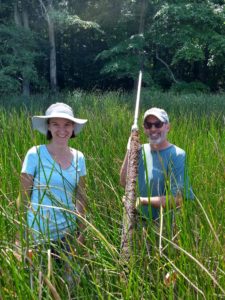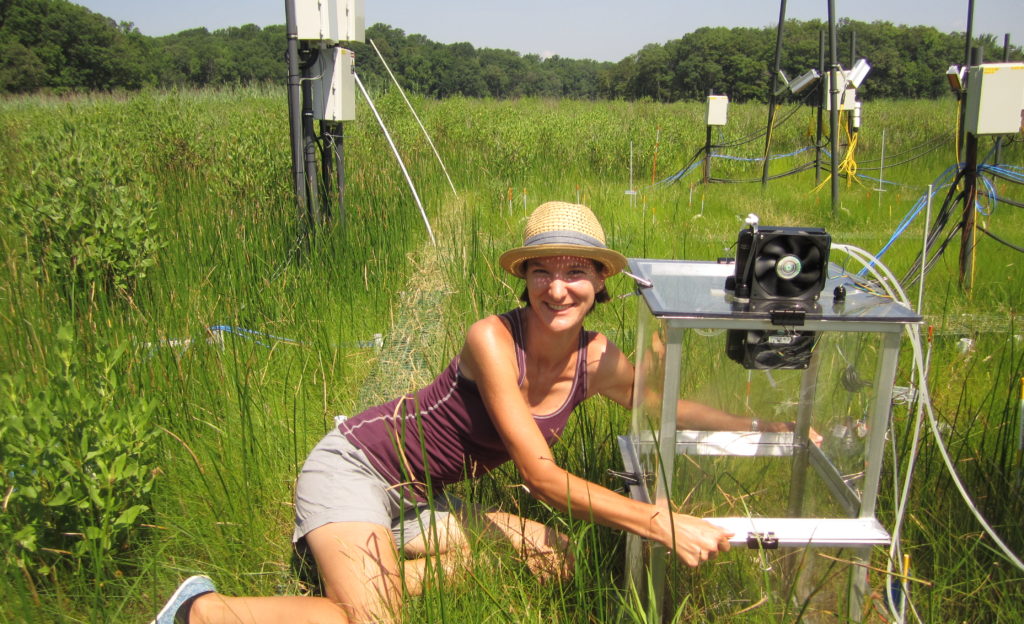by Kristen Minogue

Soils don’t get much credit for their work powering the environment. Even among scientists, they’re routinely overshadowed by their flashier plant neighbors. But as the planet heats up, hidden soil microbes are on the verge of giving plant growth a serious boost.
However, there’s a hiccup in the system. In a new global warming study, ecologist Genevieve Noyce discovered soils and plants are just a couple degrees out of synch.
It boils down to one crucial ingredient: nitrogen. Plants need nitrogen to grow, so it’s a major component of most fertilizers. In the absence of fertilizer, plants get their nitrogen from soil microbes. But they’re at the mercy of supply and demand. In most environments on land today, soil microbes can’t produce nitrogen fast enough to meet plant demand.
In a futuristic experiment, Noyce and her colleagues baked patches of wetland soil to see if that would change in a warmer world.
Some Microbes Like It Hot(ter)
Noyce works as a postdoc at the Smithsonian Environmental Research Center, on the Global Change Research Wetland. Here, ecologists have been running futuristic global change experiments for the last three decades—fast-forwarding to the year 2100 by raising carbon dioxide and other key variables inside plastic chambers.
Noyce’s main project goes by the name SMARTX (“Salt Marsh Accretion Response to Temperature eXperiment”). The experiment was born in 2016, engineered by a team of ecologists including Roy Rich, Noyce, Pat Megonigal and Matt Kirwan. Using infrared lamps and underground wires, SMARTX heats patches of the wetland 1.7, 3.4 and 5.1 degrees Celsius higher than today (about 3.1, 6.1 and 9.2 degrees Fahrenheit). These temperatures mirror three possible futures scientists predict for the next century.
For two years, Noyce watched wetland sedges grow in the experimentally heated plots.
“For the most part I expected that we’d see the same effects at all the temperatures,” she said. “You’d have a little bit of an effect with the 1.7, and then a little bit larger at 3.4 and larger at 5.1.”

But instead, she saw something radically different. At the lowest warming (1.7°C), the plants’ root growth shot up—a sign that they were even thirstier for nitrogen and needed more roots to suck it out of the soil. But at higher temperatures, that stopped. Root growth dropped back to normal. At the hottest temperature (5.1°C higher), plants saw the biggest total growth—about 20%. However, most of it went not to their roots, but to their showy green stems.
At first, Noyce reacted to the data with mild terror. “Oh, shoot, did I screw something up?” she remembered thinking. “Why does it look like this?”
The answer was in the soil. Scientists have long known that when soil heats up, microbes get excited and produce more nitrogen. But a mere 1.7 degrees warmer wasn’t enough for these microbes.
“The microbes aren’t responding with the low temperature,” Noyce said. “It’s only once you get up to 3.4 degrees of warming.”
Once it got hot enough for microbes to crank out more nitrogen, plants didn’t need so many roots. Porewater samples from the marsh confirmed Noyce’s theory: At lower 1.7-degree warming, nitrogen in the water dropped, meaning plants were absorbing nitrogen faster than microbes could replace it. But at higher temperatures, with microbes energized, porewater nitrogen rebounded.
It would have been very easy to miss that discovery, Noyce pointed out. Many global warming experiments test only two temperatures—normal, and something higher.
“If we’d only done 1.7 or if we’d only done 5.1 [degrees], we would have had very different results,” she said.
Because SMARTX tested four temperatures, it was able to catch the spot where a switch turned on in the soil.

The perfect bake?
Today, plants are still taking nitrogen out of the soil faster than microbes can replenish it, explained Pat Megonigal, director of the Global Change Research Wetland where the experiment took place. But that trend may not last.
“Our experiment suggests that warming beyond 2 degrees will change this pattern as warmer microbes release more nitrogen, and plants in natural ecosystems will grow a bit faster as a result,” he said.
For many plants, the extra nitrogen that comes with a 2 or 3-degree increase could be a boon. Without the pressure to grow so many roots, they’re free to grow more green stems, capturing more carbon for photosynthesis.
But wetlands need their roots. Roots help build and stabilize soil, enabling wetlands to grow higher and possibly avoid getting washed away by sea level rise. For these ecosystems, free nitrogen could spell serious trouble.
The international Paris Agreement aims to keep Earth below 2 degrees Celsius of warming. Noyce’s work suggests that a close 1.7-degree increase could be a sweet spot for wetlands. At that range, wetland plants would still feel the need to grow deep roots, increasing their odds of outpacing sea level rise. But somewhere above that, soil microbes begin to awaken. Wetlands may look lusher aboveground thanks to extra nitrogen, but they’ll be more fragile belowground where it counts.
The full research article, “Asynchronous nitrogen supply and demand produce nonlinear plant allocation responses to warming and elevated CO2,” was published in the Oct. 22, 2019, issue of the Proceedings of the National Academy of Sciences. It is available at https://doi.org/10.1073/pnas.1904990116.
Learn more:
Cranking Up The Heat in the “Wetland of the Future”
High Carbon Dioxide Can Create “Shrinking Stems” In Marshes

